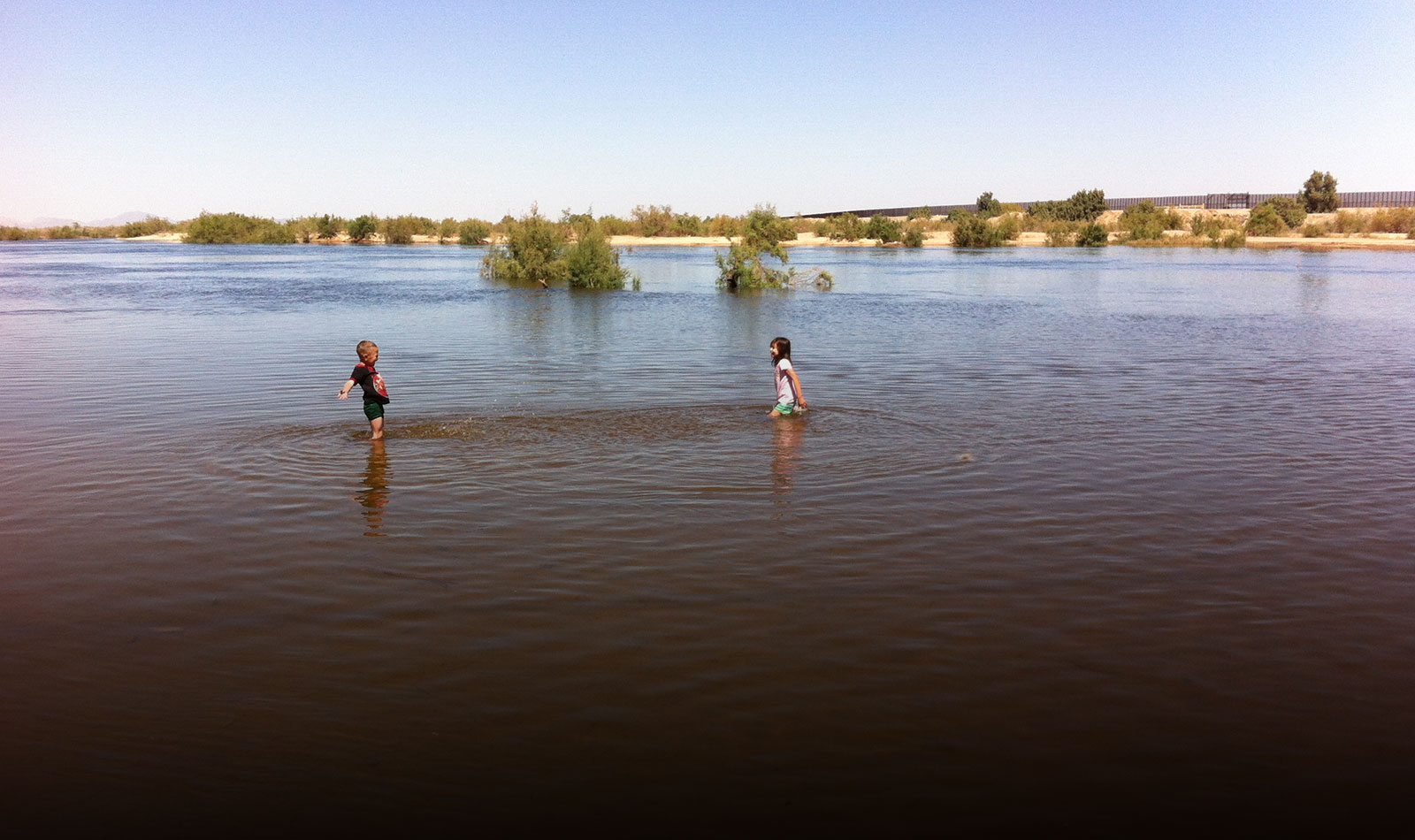Historic cooperation results in hope for environmental restoration
Cooperation between the U.S. and Mexico governments, supported by a coalition of non-profit organizations, is demonstrating the power of community to achieve environmental benefits, as recently released scientific findings in the Colorado River Delta have documented.
 The Colorado River is one of the world’s most endangered rivers. Dams and water diversions for farms and cities upstream in both countries deplete the water before it meets it natural end in the Gulf of California. Its delta, once a vibrant habitat for wildlife and migrating birds, is now dry, as the river stops 70 miles short of the sea. A unique and landmark bi-national collaborative effort to revive the dry delta landscape on behalf of the environment came together in 2014, followed by an engineered release of water into the region – known as a ‘pulse flow’ – which flooded the dry Colorado River Delta and reconnected habitats, wildlife, and local communities with the river for the first time in decades.
The Colorado River is one of the world’s most endangered rivers. Dams and water diversions for farms and cities upstream in both countries deplete the water before it meets it natural end in the Gulf of California. Its delta, once a vibrant habitat for wildlife and migrating birds, is now dry, as the river stops 70 miles short of the sea. A unique and landmark bi-national collaborative effort to revive the dry delta landscape on behalf of the environment came together in 2014, followed by an engineered release of water into the region – known as a ‘pulse flow’ – which flooded the dry Colorado River Delta and reconnected habitats, wildlife, and local communities with the river for the first time in decades.
On October 21, the International Boundary Water Commission (IBWC) published the “Minute 319 Colorado River Limitrophe and Delta Environmental Flows Monitoring Interim Report“, an interim report on the environmental impact of this 2014 pulse flow, plus subsequent supplemental deliveries of water through December 2015. Research on the effects of the 2014 pulse flow will continue through 2017 with a final report due in June 2018. A binational, University of Arizona-led team of scientists and environmental experts – including those from The Nature Conservancy, Pronatura Noroeste and the Sonoran Institute – contributed to the report. These three organizations are all members of Raise the River, a coalition of conservation organizations working to protect and restore the Colorado River Delta. Other members of Raise the River include the National Audubon Society, The Redford Center, and Restauremos El Colorado.
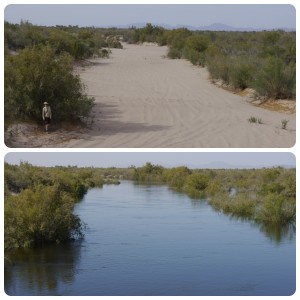 The IBWC and its Mexican counterpart (CILA) are U.S. and Mexican federal agencies that negotiate and implement binational water treaties and water allocations. In 2012, the IBWC and CILA successfully negotiated Minute 319, an amendment to the 1944 U.S.-Mexico Water Treaty (modifications of treaties are referred to as minutes). Minute 319 included the authorization of environmental flows of water into the Colorado River Delta from 2013 to 2017, and was the first binational agreement in the world to dedicate flows for environmental purposes. The result of extraordinary binational collaboration among government agencies, conservation organizations, water users, and other Delta stakeholders, Minute 319 provides multiple benefits for water users on both sides of the border. In addition to the water flows, it more broadly provides for the U.S. and Mexico to share surpluses in times of plenty and reductions in times of drought, offers incentives for leaving water in storage, and conserves water through joint investments in projects from water users in both countries. The agreement also served to recognize the Colorado River Delta as a place of global ecological significance.
The IBWC and its Mexican counterpart (CILA) are U.S. and Mexican federal agencies that negotiate and implement binational water treaties and water allocations. In 2012, the IBWC and CILA successfully negotiated Minute 319, an amendment to the 1944 U.S.-Mexico Water Treaty (modifications of treaties are referred to as minutes). Minute 319 included the authorization of environmental flows of water into the Colorado River Delta from 2013 to 2017, and was the first binational agreement in the world to dedicate flows for environmental purposes. The result of extraordinary binational collaboration among government agencies, conservation organizations, water users, and other Delta stakeholders, Minute 319 provides multiple benefits for water users on both sides of the border. In addition to the water flows, it more broadly provides for the U.S. and Mexico to share surpluses in times of plenty and reductions in times of drought, offers incentives for leaving water in storage, and conserves water through joint investments in projects from water users in both countries. The agreement also served to recognize the Colorado River Delta as a place of global ecological significance.
Following the signing of Minute 319, more than a year of work by a multinational, multidisciplinary, multi-organizational science team went into preparations for designing the pulse flow and establishing the monitoring requirements for its hydrologic and ecological responses. Then, between March 23 to May 18, 2014 nearly 106,00 acre-feet of water was released from Morelos Dam into the dry Delta, flooding more than 4,000 acres of riverbed landscape, and once again – briefly – the river met the sea for the first time since 1997. (An acre-foot is the volume of water required to cover one acre of land to a depth of one foot – approximately the amount of water a family of five uses in one year.)
Following the pulse flow, small increments of water—known as base flows—were periodically released into the delta to maintain the pulse flow’s effects.
“Like the pulse flow itself, this report was a binational collaboration. Scientists from government agencies, academia, and conservation organizations on both sides of the border contributed to the monitoring efforts,” said Eloise Kendy, a senior freshwater scientist with the North America Water Program of The Nature Conservancy.
The team, and the study
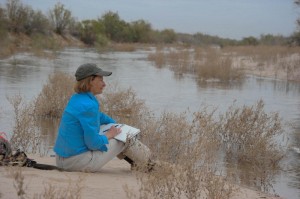 The monitoring team includes more than 21 scientists from universities, government agencies and nongovernmental organizations from both Mexico and the U.S., including El Colegio de la Frontera Norte, Pronatura Noroeste, The Nature Conservancy, Sonoran Institute, the Universidad Autónoma de Baja California, the University of Arizona, the U.S. Geological Survey and the U.S. Bureau of Reclamation.
The monitoring team includes more than 21 scientists from universities, government agencies and nongovernmental organizations from both Mexico and the U.S., including El Colegio de la Frontera Norte, Pronatura Noroeste, The Nature Conservancy, Sonoran Institute, the Universidad Autónoma de Baja California, the University of Arizona, the U.S. Geological Survey and the U.S. Bureau of Reclamation.
The study results released on October 21, 2016 detailed the increase in birds, plants, and groundwater in the delta since the pulse flow, which signifies that these water flows in the Colorado River Basin could help restore the native environment and bring back native flora and fauna to the arid Colorado River delta.
“The findings confirm that what scientists and conservationists are doing for the delta is working”, said Jennifer Pitt, Director of the National Audubon Society’s Colorado River Project, who has been among the leaders of the delta restoration effort for many years. “It’s proof positive that adding a little water back into that ecosystem can work”.
Notable findings
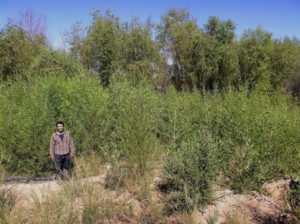 Included among the findings of the study are the following five notable achievements that resulted from this historic cooperative effort:
Included among the findings of the study are the following five notable achievements that resulted from this historic cooperative effort:
- Plants: Native plant life returned, with a 16% increase in density of green vegetation recorded by satellite imagery in the floodplain one year following the pulse flow.
- Although greenness declined in 2015, it was still greener in 2015 compared to 2013, indicating that the single pulse flow in 2014 stimulated plant growth for at least one year.
- Native plants – including cottonwood, mesquite, and willow seedlings – grew much better in restoration areas where non-native vegetation was removed before the pulse flow, as well as in areas actively managed following the primary release of water.
- Birds: Greater bird abundance and diversity was recorded, with both the number and diversity of bird species increasing significantly from 2013 to 2015.
- This was particularly notable where trees were planted, with the highest concentrations in the restoration sites.
- Of the 19 species monitored for conservation interest, an increase of 49% was recorded from 2013 to 2015.
- Groundwater: Results indicated that pulse flow also recharged groundwater in the delta, an important resource for some native tree and shrub species.
- Community: Beyond wildlife, the pulse brought together local residents, from older generations who remembered the river, to younger generations who had never before seen it flow.
“The social response—that was amazing,” says Dr. Osvel Hinojosa Huerta, Director, Water and Wetlands Program of Pronatura Noroeste. He recalls what happened in the border city of San Luis Río Colorado, where the namesake river had largely vanished. “When the river came back, it was like a party in town every day. Thousands of people were celebrating in the river.”
- Precedent-setting: The study results will be used to inform future bi-national cooperation efforts on behalf of the river. The science team learned a great deal about how water moves through the delta ecosystem and is, for the first time, equipped with data-driven recommendations for future restoration activities. Notably, the pulse flow is setting a precedent for water-sharing agreements globally, as well as inspiring water rights advocates far beyond the region. Raise the River coalition members Pitt and Hinojosa Huerta say that groups involved in river restoration from as close to home as the Rio Grande to as far as Central and Eastern Asia have reached out to express interest in the water sharing concept.
Small amount, large impact
Less than 1 percent of the Colorado’s historic flow to the delta was returned by the flows sanctioned under Minute 319, yet the strategic timing and placement of the water supported the thesis that a small amount of water is sufficient to restore crucial habitat for the birds and wildlife that have historically lived in the delta. It also provided lessons learned to be applied to future water deliveries.
“The most important lesson we learned is that a relatively tiny bit of water can go a long way toward restoring the Delta” added Kendy. “Water expeditiously applied to prepared floodplain areas has established new native trees that are already way over my head”.
The work continues
With Minute 319 concluding in 2017, researchers and coalition members of Raise the River are currently negotiating a successor agreement to support continued cooperative work between Mexico and the U.S., with the hope of having this in place by the end of this year. Just as the report showed that active restoration sites achieved the highest success rate, the restoration of the delta is a long-term process.
“This project demonstrates that a relatively small amount of water, particularly when coupled with active restoration, can provide significant benefits to rivers with reduced flows,” states Karen Schlatter, Adaptive Management Specialist for the Colorado River Delta Program, Sonoran Institute. “When diverse stakeholders collaborate on Colorado River water management, governments, communities, and the environment have much to gain.”
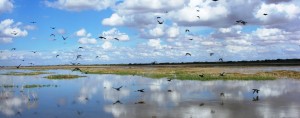 The report results show that the flows created new habitat, increased bird diversity, and also provided a meaningful reconnection of local communities to the environment, offering hope for the region.
The report results show that the flows created new habitat, increased bird diversity, and also provided a meaningful reconnection of local communities to the environment, offering hope for the region.
Working together, greater good can result, as the recent monitoring report on the Spring 2014 “pulse flow” of water into the Colorado River Delta has validated.
Raise the River Coalition Partner Reports:
- National Audubon Society, October 21, 2016 — Pulses of Water Bring Life to the Famished Colorado River Delta;The Colorado River is one of the world’s most endangered rivers. But recent pulses of water have started to bring life back to the famished region.
- Sonoran Institute, October 26, 2016 — Ever wonder what Minutes have to do with Water?There’s been a lot of news coverage on a recent report about our historic work in the Colorado River Delta. This report answers your FAQ’s and gets you up to speed with this groundbreaking environmental project.
- The Nature Conservancy, October 31, 2016 — Top Four Scientific Results of the Pulse Flow; Highlights of the Interim Report issued by the International Boundary Water Commission, United States and Mexico sections, outlining the scientific results to date of the 2014 “pulse flow” of water into the Colorado River Delta.
- Additional media coverage can be found on the Raise the River website, in our “Press” sectio

